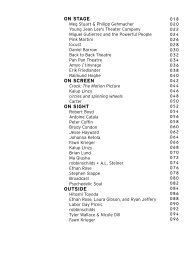BOMB Magazine: Shirin Neshat by Arthur C. Danto
BOMB Magazine: Shirin Neshat by Arthur C. Danto
BOMB Magazine: Shirin Neshat by Arthur C. Danto
Create successful ePaper yourself
Turn your PDF publications into a flip-book with our unique Google optimized e-Paper software.
SN Yes.<br />
<strong>BOMB</strong> <strong>Magazine</strong>: <strong>Shirin</strong> <strong>Neshat</strong> <strong>by</strong> <strong>Arthur</strong> C. <strong>Danto</strong> 5/17/10 1:58 PM<br />
AD I thought so. It’s in color. There is a mythic quality to the black and white, but it<br />
was important for what you were trying to do that you did use color. Aesthetically<br />
it’s very successful. I felt that this was a conversation of a woman with herself. The<br />
two screens work a bit the way they do in Turbulent; she sees herself and whether<br />
it’s an image, a dream, or a memory—you can’t quite discover. Although there is<br />
what I think of as the more traditional setting: there is a child and some tragedy is<br />
implied. Whereas the worst thing that seems to be happening to the woman in the<br />
other, Western setting is loneliness. That is to say she’s there and the crowds sweep<br />
<strong>by</strong>, and she goes up the staircase. It reminded me of one of Maya Deren’s earlier<br />
surrealist films. I thought it was wonderful <strong>by</strong> the way, but I felt at the same time<br />
that it was tentative.<br />
SN Many people, including critics and curators, have been comparing the last few<br />
works I have made, telling me which one they think succeeds or does not work as<br />
well. I think what is more important is the developmental process, and looking at<br />
how each work visually and conceptually takes the ideas forward. Soliloquy has<br />
almost no relation to the trilogy that we’ve been speaking about, but it’s a topic that<br />
I had wanted to make a film about for a long time; and perhaps the most personal<br />
work I’ve ever made. It’s about imagining the emotional state of a woman standing<br />
at the threshold of two opposite worlds. She is constantly negotiating between two<br />
cultures that are not just different from one another but in complete conflict. So<br />
once again the idea of opposites applies but in a different way. The location in the<br />
East [Turkey], where it was shot, is the place of her origin. It is ancient, traditional<br />
and communal but also a controlling society, at times suffocating, as there is no<br />
personal—individual—space. The location in the West [The United States] is in a<br />
modern, free, extremely individualistic society where we sense a great personal<br />
isolation and loneliness. By the end we find that the woman never quite feels at<br />
peace in either space.<br />
AD Do you feel at the end that both states of the woman, or stages, are rushing to<br />
meet one another? How could you show that they do get together? Of course, it<br />
would be impossible, but . . .<br />
SN That is the ambiguity that I wanted to maintain; it’s not really clear where she<br />
was running to or from. Once you leave your place of birth, there’s never a<br />
complete sense of center: you’re always in the state of in between and nowhere<br />
completely feels like home.<br />
AD I understand you shot Soliloquy in Turkey, but do you have any plans to work in<br />
Iran?<br />
SN It has been a dream for me to finally work in my own country. Slowly, I am<br />
advancing in that direction although the country is still in a state of flux so one<br />
never really knows if it is completely safe to work there or not. But recently I did<br />
have a major breakthrough. I was contacted <strong>by</strong> the minister of culture, the director<br />
of the visual arts who also happens to be the director of the Museum of<br />
Contemporary Art in Tehran! He officially invited me to come to Iran to work, exhibit<br />
and meet with local artists. According to this gentleman, there should not be any<br />
problems but I have been told to be cautious. However, if things don’t quite work in<br />
Iran, I will go back to other Islamic countries, Morocco and Turkey, as I have been.<br />
In all my work, I am dealing with issues that address historical, cultural,<br />
sociopolitical ideas; but in the end, I want my work to transcend that and function<br />
on the most primal and emotional level. I think the music intensifies the emotional<br />
quality. Music becomes the soul, the personal, the intuitive and neutralizes the<br />
sociopolitical aspects of the work. This combination of image and music is meant to<br />
create an experience that moves the audience. It is an expectation that I have as<br />
an artist and I want that intensity from any work of art; I want to be deeply<br />
affected, almost like asking to have a religious experience. Beauty is important in<br />
relation to my work. It is a concept that is most universal, it goes beyond our<br />
cultural differences.<br />
AD I believe that. There’s been a kind of cynicism in regard to beauty, that it’s<br />
entirely relative. At any rate, I’m thinking myself about it a great deal,<br />
philosophically. I’m trying to write a book on that.<br />
SN It is particularly important in relation to my subject since in Islam, beauty is<br />
critical, as it directly ties to ideas of spirituality and love of God.<br />
http://bombsite.com/issues/73/articles/2332 9 of 10






